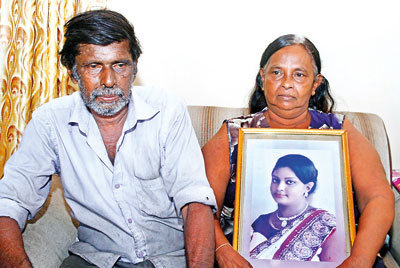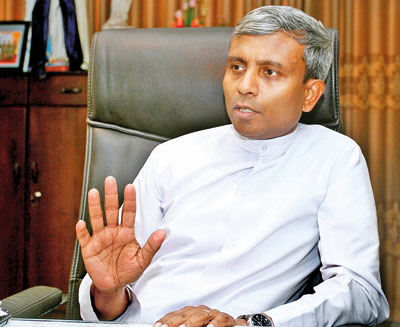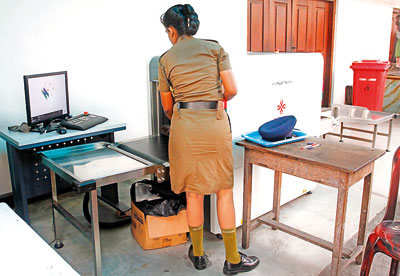News
Waiting for justice with slow-healing wounds: Looking back on Easter Sunday attacks
View(s):By Tharushi Weerasinghe
On Thursday, the Sunday Times visited survivors of the bombing at St. Sebastian’s Church in Katuwapitiya, one of several sites targeted in the devastating Easter Sunday attacks of 2019, which killed over 250 people and injured more than 500. Six years later, frustration over the lack of justice continues to grow.
Many declined interviews—some angrily. “It has been six years of the same circus every time the commemoration or an election comes around, and my child is still dead with no one held responsible,” said one grieving mother who lost her daughter. She refused to speak further.

Theresa Peiris points to the pictures of her family members who lost their lives that fateful Easter Sunday. Pix by Indika Handuwala
The Easter attacks were a series of coordinated suicide bombings at three churches—St. Anthony’s Shrine in Kochchikade,
St. Sebastian’s Church in Negombo, and Zion Church in Batticaloa—and three luxury hotels in Colombo on April 21, 2019.
For survivors and the families of victims, hope for justice has been sustained by a stream of reports, claims, and political promises. In 2022, a Channel 4 documentary alleged the attacks were part of a premeditated plan involving the Rajapaksa family to create chaos ahead of the presidential election, ultimately won by Gotabaya Rajapaksa.
More recently, President Anura Kumara Dissanayake rekindled hopes for accountability. In October last year, he stood inside St. Sebastian’s and promised to expedite justice. Last month, he pledged to reveal “a significant number of names” before April 21. With one day remaining, the nation waits.
“I was outside the church with my family because it was crowded, and there was a sudden boom,” recalled J. A. Harshani, 41. Her husband dragged her home, then returned with a megaphone to call for blood donors. She didn’t realise she had a ruptured eardrum until weeks later. “I still react badly to loud noise, but the pain is better,” she said, grateful for the church’s medical camp that helped her.

J.A. Harshani: A survivor
Others feel permanently displaced. “We keep leaving this house because it’s too painful to stay, but come back because there’s nowhere else to go,” said Rita Dias, 61, who lost her 28-year-old daughter in the church bombing. She holds up a photo of her in a red saree, dressed for her sister’s homecoming. “The pain never leaves—her brother became reclusive, and her father and I cry every night because that’s all we can do.” In the weeks before the attack, Rita recalls feeling inexplicable sorrow and having disturbing dreams. “She was singing hymns one day and gone the next.” The family received Rs. 1 million in compensation, but no answers.
Most of the survivors that the Sunday Times met affirmed that they received compensation from either the church or the government. The exceptions were often the result of familial disputes.
Theresa Peiris, 72, lost seven family members—her son and two grandchildren, and her daughter and her three children, all of whom lived with her. Compensation was given to their surviving spouses, who have since cut ties with her and remarried.
“I choke up every time I sit here and eat while staring at their photos,” she said, pointing to framed photos of her departed family. As a single mother who raised her children after her husband died young of cancer, she says she has lost hope in the authorities.
“We tried to make a complaint about Udaya Gammanpila toying with this by saying he’d reveal who did it, but police refused to accept it,” she said. “I’m just existing now. Justice feels more distant every day.”
Theresa says the community has been exploited by politicians, NGOs, and even the media. “So many NGOs came and took photos of me. I have no idea why. We’re remembered only when there’s a grant or an election to win.”

Rita Dias and husband with a photograph of their daughter
Many survivors commended the church for the psychosocial support they received during their recovery.
“My son was afraid to return to church until recently, but church counselling has helped,” said Thilanga Sandamal, 43, whose 8-year-old son was the only survivor on his pew that Easter. The family received a home through a housing scheme jointly built by the Catholic Church and the Government. Every Saturday, residents gather in the central garden to say the rosary. “Faith has grown in this community, but hope for justice is fading—after six years, even a child can see what happened. Why are we expected to believe these excuses?”
His wife, Nishani Kumari, 41, was also injured. “I remember the sound, then nothing. I couldn’t move or see through the dust,” she said. “I searched for my son and called Sandu, who was at home.” Nishani still has shrapnel in her left arm. “Doctors say removing it could damage the nerves and paralyse it.”
In Katuwapitiya, most of the houses along St. Sebastian Road are empty because people who left for Easter that fateful day never came home. Litigation over ownership has now started over some of the presently unoccupied lands.
“This is a very resilient community,” said Rev. Fr. Manjula Niroshan, parish priest of St. Sebastian’s Church. He noted that over the past six years, it was the congregation itself that carried the community through the healing process.

Fr. Jude Fernando
Special security is now routinely provided during events at the church. Discussions are underway with the Ministry of Health to introduce physical and mental health interventions for survivors, potentially with support from nearby hospitals. However, these plans face significant practical challenges and remain in early stages.
“A lot of the issues are resolved,” said Rev. Fr. Niroshan. “Trauma and permanent injuries are still there. People are starting to try to rebuild their lives.”
Most survivors have received compensation, which was distributed according to a decision by the Supreme Court. Scholarships were granted, and elderly victims received support through a separate scheme. Those who are no longer in critical need due to the attack are the only ones who haven’t received compensation.
Aid efforts have been scaled down to prevent misuse. As one of the final major recovery initiatives, houses are being built for the most affected families, particularly where the breadwinner had died. Of the ten houses planned, nine are complete and will be handed over to families tomorrow. The project cost Rs. 103 million, of which Rs. 12 million came from the government. “We found the rest ourselves,” Fr. Niroshan said. While homes are given to support survivors, ownership lies with the Church.
The government also rebuilt the church and funded the Sunday school and smaller projects. Limited support has come from Jayawardenapura Hospital, which offers occasional access to specialised services for a small group of survivors.
Despite initial tensions following the attack, the parish has upheld the non-violence principle laid down by the Cardinal. “We have repeatedly intervened in the community to ensure this doesn’t spill into conflicts based on faith,” said Fr. Niroshan. “There is hurt and anger, which we are resolving through relationship and counselling.”

Fr. Manjula Niroshan
He acknowledged that while faith has persisted, some individuals continue to struggle. “There are people still on the way to recovery who are aggressive,” he said. “Priests do home visits and check on these people, and this continuous process has helped the community—many people are turning this situation around.”
In Zion Church, Batticaloa, however, reconstruction of the destroyed building has been stalled indefinitely since November 2019. “In June 2019, it was estimated that the reconstruction would cost Rs. 37 Mn, out of which Rs. 7 Mn was allocated to the Army Engineering Unit by then Minister Sajith Premadasa’s Ministry,” said Rev. Fr. Roshan Mahesan who heads the church.
The attack, the only one outside of the Western Province, resulted in 31 casualties, including 14 adults and 17 children. The church building and the residences of the pastors were damaged or destroyed.
Then Prime Minister Ranil Wickremesinghe had visited the site and promised it would be rebuilt in time for Christmas 2019, but construction stopped when the money stopped coming in after the presidential election that year.
“When Former President Ranil Wickremesinghe visited me in July 2024, he ordered the construction to resume, and the new estimated cost was Rs. 97 Million, but they never started the work,” said Fr. Roshan.
An initial payment of Rs. 100,000 was provided to each victim’s family. Subsequently, compensation was distributed through the Divisional Secretariat (DS) office to the injured, based on medical assessments from hospital doctors. More recently, additional financial assistance was given to the families of victims and the injured, though this was done directly without prior notification. Dialog continues to support the education of affected children through Sarvodaya.
When the Sunday Times asked to speak with survivors, Fr. Roshan noted that people were no longer willing to talk about the past. “What has happened has happened, and our people are looking to the future.” Despite the lack of support from the government, the church has managed to rebuild on its own, and the community is continuing to pursue its faith with fervour.

Baggage Scanner at St. Anthony's shrine in Kochchikade
In St. Anthony’s shrine in Kochchikade, traditions that were paused for a long time are being restarted this year. “We used to carry the crucifix around the area on Good Friday, but we couldn’t do it due to the multiple crises in our country over the last few years, but we are bringing the tradition back this year,” said head priest Rev. Fr. Jude Fernando.
Security would be heightened as usual, he noted. This was the case for churches across the country during special events. A baggage scanner was also given to the church by the police in December last year, which is currently in use for visitors to the shrine. Tri-forces will be present during special services, apart from the constant navy presence within the shrine itself, and patrols will be made by law enforcement in the area during regular intervals.

Houses under construction to be handed over to survivors on the 6th commemoration of the attacks
“We have observed a rise in the number of visitors in recent months, the majority of whom are not Catholics,” said Rev. Fr. Fernando, noting that the shrine is respected by people of all faiths.
“Faith is continuing to win and give peace despite what has happened.”
Commenting on the progress made on the investigations so far, Director of Communications for the Archdiocese of Colombo, Rev. Fr. Jude Krishantha, noted that the community was still holding on to its hope for justice. “We welcome any efforts by the government to identify and bring the perpetrators of the attack to justice and acknowledge that our hopes are placed in this process, as we continue to wait with faith.”
The best way to say that you found the home of your dreams is by finding it on Hitad.lk. We have listings for apartments for sale or rent in Sri Lanka, no matter what locale you're looking for! Whether you live in Colombo, Galle, Kandy, Matara, Jaffna and more - we've got them all!

